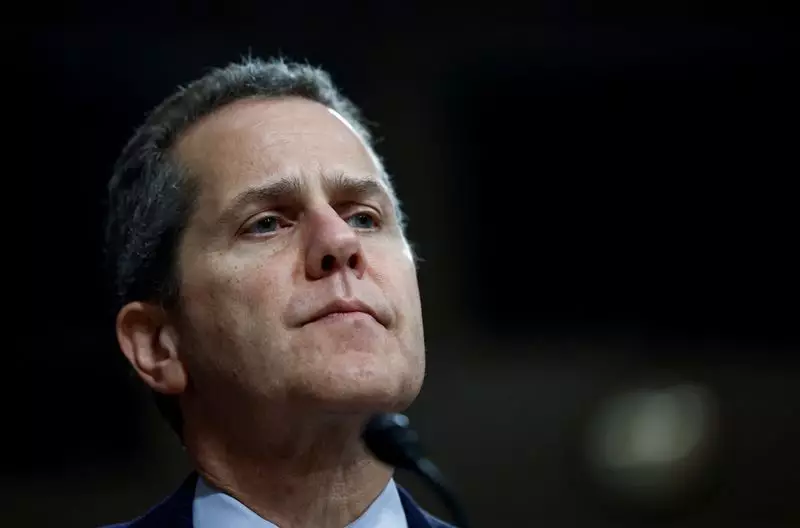The recent announcement of Michael Barr’s resignation from his role as the Federal Reserve’s vice chair for supervision marks a significant turn in U.S. banking regulations and the broader economic landscape. This pivotal decision, taking effect on February 28, 2021, not only paves the way for a new administration’s approach to banking oversight but also raises questions regarding the Federal Reserve’s independence and its capacity to enforce regulations that safeguard financial stability.
Michael Barr’s decision to step away from his regulatory role can be attributed to the shifting political environment following the election of President Donald Trump. Although Barr’s term was not set to conclude until 2026, he opted to resign in the interest of avoiding an extensive legal conflict, hinting at potential chaos that could detract from the Federal Reserve’s primary mission of maintaining economic stability. The implications of this move are multifaceted, influencing both the composition of the Federal Reserve Board and its regulatory agenda.
Historically, the Federal Reserve has operated independently from direct political influence, ensuring decisions are made based on economic considerations rather than political motivations. However, Trump’s impending presidency represented a shift towards a more industry-cozy regulatory landscape, with an expectation of appointing officials who could facilitate a deregulation-friendly environment. This presents a dilemma: while the administration seeks to bolster bank performance through reduced oversight, the long-term implications on stability and consumer protection must be considered.
Barr’s decision to remain on the Fed’s Board of Governors limits the new administration’s choice of successors but does not entirely remove the possibility of significant changes. With no vacancies on the Board until 2026, appointing a new regulatory chief could require reshuffling within existing ranks, such as promoting individuals like Fed Governor Michelle Bowman or Christopher Waller. Financial lobbyists and analysts now speculate on how these potential candidates might approach banking regulations, especially following Barr’s ambitious attempts at tightening requirements on major banks.
Under Barr’s leadership, several initiatives aimed at fortifying the banking sector faced formidable opposition from the industry. Notably, Barr introduced the “Basel III Endgame” proposal, designed to enhance capital requirements for large financial institutions. However, substantial pushback from bankers and financial entities hindered these reforms, leading to questions about their future viability. With Barr’s exit, these regulatory efforts may stall or transform dramatically, emphasizing the delicate balance between fostering a healthy banking environment and ensuring consumer safety.
The Market Response and Investor Sentiments
Marketplace reactions to Barr’s resignation provide a telling glimpse into the broader economic sentiment. Following the announcement, stock prices for major U.S. banks surged, indicating a favorable reception from investors anticipating less onerous regulatory scrutiny. A notable rise in the shares of Citigroup, Bank of America, and other regional banks further underscores this optimism amongst financial circles, suggesting that the anticipation of lessened regulatory pressures could potentially enhance profitability for these institutions.
Markets respond acutely to regulatory changes, as heightened oversight often translates into increased operational costs for banks. Therefore, the shift in leadership at the Federal Reserve heralds a significant shift in investor sentiment, one that prioritizes potential gains over concerns regarding long-term financial health and systemic risk.
Barr’s resignation is occurring amidst broader discussions about the Federal Reserve’s independence, a vital aspect of its functionality. The potential for increased political, particularly executive branch, influence over the Federal Reserve raises significant concerns about its ability to effectively manage monetary policy devoid of outside pressure. Barr’s departure, coupled with the incoming administration’s inclination toward regulatory laissez-faire, may lead to a Congressional interest in reinforcing the Fed’s independence amid rising scrutiny.
As the landscape changes with Trump’s administration, the central question remains: will the Fed maintain its protective stance over the U.S. banking system, or will it embrace a new era of deregulation that prioritizes profit over predictive safeguards? Analysts widely believe that while the incoming changes present opportunities for banks, they also pose risks that could destabilize the financial ecosystem if not meticulously balanced.
Michael Barr’s resignation symbolizes a pivotal juncture for U.S. banking policy, one that straddles the line between enhanced economic opportunity and the foundational principles of consumer protection. As the Federal Reserve prepares for a new regulatory landscape, careful consideration must be given to the long-term implications of these changes. The balance between fostering growth and ensuring stability is an enduring challenge that demands vigilant oversight, underscoring the ongoing debate about the future of American finance and its regulatory approach amidst shifting political winds.

